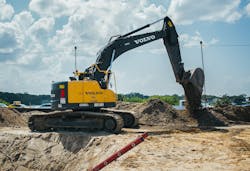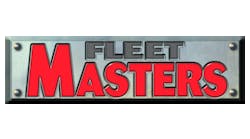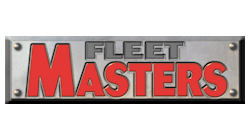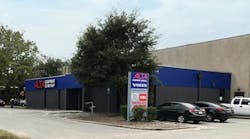Performance guarantees have so many different definitions that the line of communications between negotiating parties can get in the way of an agreement, especially when you are assembling a fleet for a joint venture project.
Skanska USA has negotiated these types of guarantees many times on a major scale and, over the years, has come up with a matrix capable of cutting a path through the undergrowth of dense, diverse data that the process accumulates. That information encompasses everything from financial factors to machine cost to maintenance and service, and just about anything else within the scope of the agreement.
Performance Guarantees
- Availability
- Production capacity
- Total operating expense
- Operator training
- Warranty
Skanska’s matrix method has been successfully field-tested “in all four corners of the United States: New York, Florida, Southern California, Washington State, and Oregon,” says Mason Ford, CEM, and director of equipment services for the company.
The matrix lists equipment classification, such as excavators, graders, articulated dump trucks, cranes, and over-the-road vehicles, but it is much more than a laundry list. It’s a quick read for fleet managers to compare one brand of machine to a less expensive brand, for instance. The information allows fleet managers to compare apples to apples on price, performance, reliability, and operating cost.
Performance guarantees, some of which look more like subcontracts, are all different, depending on the type of equipment and the agreement, says Ford.
One component of the agreement could be as simple as promising that a machine is available on the job site to do the work, Ford says. “The engine starts and everything is ready to go to handle the task at hand. Another component may include the amount of time for delivery of the machine,” he says.
“If you continue to add to the performance guarantee, eventually you get to the point where the spectrum of performance guarantees is so wide it becomes a subcontract,” he says. “Subcontracts are outside the scope of this discussion. I am much more into availability and having guarantees on expenses.”
A performance guarantee, he says, can mean negotiating with a rental company guaranteeing the unit will be on the job within a two-hour period. If not, the machine is free or the user gets a discount. Or, that a rigging company will deliver a specialized lifting device and all the people needed to lift and assemble it, all in a certain amount of time. Otherwise, they would shoulder all the consequences for failure to do so.
“That’s how wide the whole performance guarantee spectrum is,” Ford says.
A lot of assumptions are made by Skanska when it comes to commodity-type equipment, such as excavators, wheel loaders of various horsepower and capabilities, even the mandatory compaction equipment.
“All assets like these have spec sheets or performance handbooks that are really well substantiated,” he says. “Specs are distributed and understood (regarding) capability and capacity.”
Managers should also consider including operator training in negotiating performance agreements, according to AEMP’s Career Equipment Fleet Manager manual. Many OEMs have intelligent product simulators available as a tool to assist maximizing productivity from both the asset and the operator. This input-to-performance guarantee is often overlooked and underutilized, according to the manual.
Yet negotiations change and fleet managers “enter a different zone” when it comes to custom-built, one-of-a-kind machines, he says, such as tunnel-boring equipment.
“This kind of equipment has a heavy-duty guarantee that typically says we, as end users, won’t pay the last 10 percent installment on the machine until it has successfully bored through the designated portion of the tunnel.”
The performance guarantee can also address warranty. Ford uses the following example: A warranty says that the hydraulic system on a 200 Class excavator will last for a certain length of time. If not, the supplier will cover the repair. Such a warranty typically would also say the vendor will not cover the transportation and won’t cover the cost of a technician or service person coming out to repair the equipment or his travel time.
And a warranty typically doesn’t say how much time it will take them to fix the machine, Ford says.
This article is reprinted with the permission of the Association of Equipment Managment Professionals. Click here for more on performance guarantees.
“So, if you have an excavator on your job that is under warranty, you may have to go to the expense of transporting the machine back to the shop, if that’s what’s needed. Then, you may be without the unit for three weeks or five weeks; a warranty usually doesn’t address this issue.”
A performance guarantee may stipulate that if the supplier doesn’t have a replacement machine available they will pay for the outside rental to replace the down machine.
But, Ford warns, you have to have this conversation, “way on the front before you’ve written a deposit check. It is not a conversation to have when the machine is being delivered. That discussion has to take place when the vendor is trying to close the sale.”
Performance guarantees help prevent fleet managers from letting machine price alone become the determining factor in their decision to buy one brand or another.
“Some brands will have a price, for all intents and purposes, that comes in a lot cheaper than others,” Ford says. “But when you compare the price cycle, to compare apples to apples with a seemingly less expensive model that nobody knows about and can’t service, you have a problem. For example, if the machine breaks down, you might find that there are no parts to back it up or parts are back ordered.”
Brand A will tell you that their machine costs more, but that’s because the equipment is reliable, is backed up by service, greater parts availability, and has a better resale value, says Ford. “Those are the terms we put in our performance guarantees. We want them to guarantee that something is available or they will pay for it and won’t charge us for machine travel time.
“If two competing companies come in with the same guarantee, then consider where the company is located,” he says. “If a technician has to be flown in, you may be charged $5,000, for example. But if the technician is right across town and is only 15 minutes away, you might be charged nothing.”
Price control also provides a competitive edge in negotiating a performance guarantee, Ford says. For instance, if Skanska has a project in Orlando, Fla., where abrasive sugar sand quickly destroys equipment undercarriages, he might compare competitive manufacturers’ machine.
“Some OEMs use a much better material than others,” says Ford. “If a bulldozer is manufactured with lower quality material, a contractor may need to replace the undercarriage every 1,500 hours. On better undercarriages, you may get 3,500 to 5,000 hours before they have to be replaced. It is important to understand and share the risks of the expense. Performance guarantees help spread that risk.
“Also, ask the OEM to prorate the undercarriage. If it fails at 2,500 hours, you get a complete replacement and the OEM will eat a share of it. At 3,000 hours, the OEM eats a smaller share and prorate it all the way to 3,500 or 4,000 hours,” he says.
Each leg of the Equipment Triangle benefits from performance guarantees, Ford says.
“All the things we’ve talked about benefit the customer,” he says. “The value the document brings to the dealer/OEM is that it levels the playing field for everyone. It allows higher-priced vendors to show off their products and prove their higher-priced equipment is a better value than some of the lower-cost brands.”
Performance guarantees can be traced back to the automotive industry, Ford says.
“BMW, [as far back as] 10 or 12 years ago, guaranteed the customer who bought a certain model [that they] wouldn’t have to do any maintenance on it for up to 50,000 miles,” he says. “The guarantee was included in the purchase price. Or the customer would not have to touch the transmission for 100,000 miles. Now, the equipment industry is increasingly doing it as well.”
More and more heavy equipment dealerships are following this trend, he says. “We’re not having to ‘mom-and-pop’ it, or having to train a bunch of technicians how to change oil,” says Ford.
OEMS and dealers will continue to make these goodwill gestures to meet customer expectations, according to Ford.
“It is not a ‘Buy America’ attitude,” he says. “It is about the value they have invested in the design of more costly machines (buy-back, resale value) and the reduction of other factors that tend to creep up costs. When all that is factored in, the numbers are very compatible between top-tier manufacturers and lower quality, [low-price] manufacturers.”





